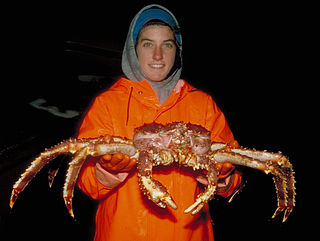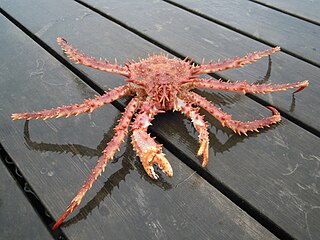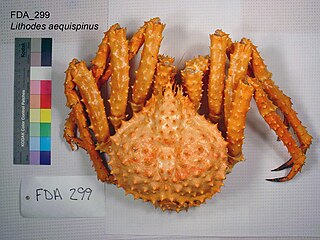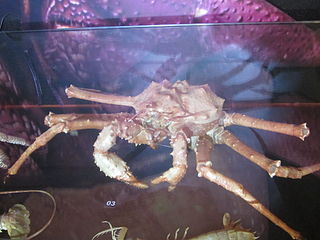
King crabs are a taxon of decapod crustaceans that are chiefly found in cold seas. Because of their large size and the taste of their meat, many species are widely caught and sold as food with the most common being the red king crab.

Eugène Louis Bouvier was a French entomologist and carcinologist. Bouvier was a professor at the Muséum national d'histoire naturelle.

Alaskan king crab fishing is carried out during the fall in the waters off the coast of Alaska and the Aleutian Islands. The commercial catch is shipped worldwide. Large numbers of king crab are also caught in Russian and international waters.

Oedignathus inermis is a species of king crab found off the Pacific coasts of the United States and Canada, from California to Alaska, and disjunctly around the coasts of Japan. It is the only species in the genus Oedignathus, and is sometimes called the granular claw crab, paxillose crab or tuberculate nestling lithode crab.

Lithodes maja, the Norway king crab or northern stone crab, is a species of king crab which occurs in colder North Atlantic waters off Europe and North America. It is found along the entire coast of Norway, including Svalbard, ranging south into the North Sea and Kattegat, the northern half of the British Isles, and around the Faroe Islands, Iceland, and off south-eastern Greenland. In the West Atlantic, it ranges from the Davis Strait between Greenland and Canada south to The Carolinas in the United States.

Lithodes santolla, also known as the southern king crab, Chilean king crab or centolla, is a species of king crab, found off southern South America including the offshore Falkland Islands. On the Pacific side, it is found in Chile from Talcahuano to Cape Horn. On the Atlantic side, it is found off Argentina and Uruguay. It lives in the benthic zone at depths of 0–700 m (0–2,300 ft), with Uruguayan records being exclusively from great depths. In Chile, it mostly lives at depths to 150 m (490 ft), but south of 40° S it can be found to 600 m (2,000 ft). It is a large crab that can reach up to 19 cm (7.5 in) in carapace length, and it is the target of commercial fishing.
Gravitaxis is a form of taxis characterized by the directional movement of an organism in response to gravity.
Lithodes galapagensis is a species of king crab described in 2009 that lives around the Galapagos Islands, where known from depths of 648 and 740 m. The two specimens upon which it was described had a carapace length of 11.4 and 8.4 cm, and the species quite resembles L. wiracocha from Peru.

Lithodes is a genus of king crabs. Today there are about 30 recognized species, but others formerly included in this genus have been moved to Neolithodes and Paralomis. They are found in oceans around the world, ranging from shallow to deep waters, but mostly at depths of 100–1,000 m (300–3,300 ft). They are restricted to relatively cold waters, meaning that they only occur at high depths at low latitudes, but some species also shallower at high latitudes. They are medium to large crabs, and some species are or were targeted by fisheries.

Careproctus is a genus of snailfishes found in benthic and benthopelagic habitats in the Atlantic, Pacific, Arctic and Southern Oceans. Whether they truly are absent from the Indian Ocean is unknown and might be an artifact of limited sampling. They range from shallow coastal seas in the far north of their range to the abyssal zone, at depths of 6 to 5,459 m (20–17,910 ft). In the Northern Hemisphere they mostly live shallower than Paraliparis, but this pattern is reversed in the Southern Hemisphere. Although almost entirely restricted to very cold waters, a single species, C. hyaleius, lives at hydrothermal vents.

Neolithodes is a genus of king crabs, in the family Lithodidae. They are found in all major oceans, both in high and low latitudes. Although there are records from water as shallow as 124 m (407 ft) in cold regions, most records are much deeper, typically 700–2,000 m (2,300–6,600 ft), with the deepest confirmed at 5,238 m (17,185 ft). They are fairly large to large crabs that typically are reddish in color and spiny, although the size of these spines varies depending on species.

Lithodes aequispinus, the golden king crab, also known as the brown king crab, is a king crab species native to the North Pacific. Golden king crabs are primarily found in the Aleutian Islands and waters nearer to Alaska and British Columbia; their range also extends to the Russian far east and Japan, albeit with a less dense population. Golden king crabs are the smallest of the three commercially viable Alaskan king crab species with an average weight between 5 and 8 lbs ; the other two species being the blue and red king crabs. Golden king crabs were historically caught incidentally in red king crab fisheries, but the first commercial landing took place in 1975; in 1981, the targeted pot-fishing method, a hybrid fishing method specifically for golden king crab, was developed.

Lithodes aoteoroa is a New Zealand species of king crab in the family, Lithodidae, and was first described in 2010 by Shane T. Ahyong. It had formerly been confused with L. longispina and L. murrayi, but neither of those species are found in New Zealand.
Lithodes megacantha is a species of king crab in the genus Lithodes. They are bright red and have been found in French Polynesia at depths of around 1,000 m (3,300 ft).
Lithodes formosae is a species of king crab. It is presently known to be found in Taiwan from depths of 500–600 m (1,600–2,000 ft).

Phyllolithodes is a monospecific genus of king crab in the family Lithodidae. Its only species, Phyllolithodes papillosus, lives in the intertidal zone and the subtidal zone. It can be found as far north as Unalaska in the Aleutian Islands and as far south as San Miguel Island in Southern California.
Lithodes macquariae is a species of king crab located off Macquarie Island, the Auckland Islands, and Peter I Island. It has been found at depths of 16–1,140 m (52–3,740 ft)
Lithodes wiracocha is a species of king crab.

Lithodes turritus is a species of king crab. It is found in Japan, the East China Sea, Taiwan, and the Philippines at depths from 300–812 metres (984–2,664 ft).











